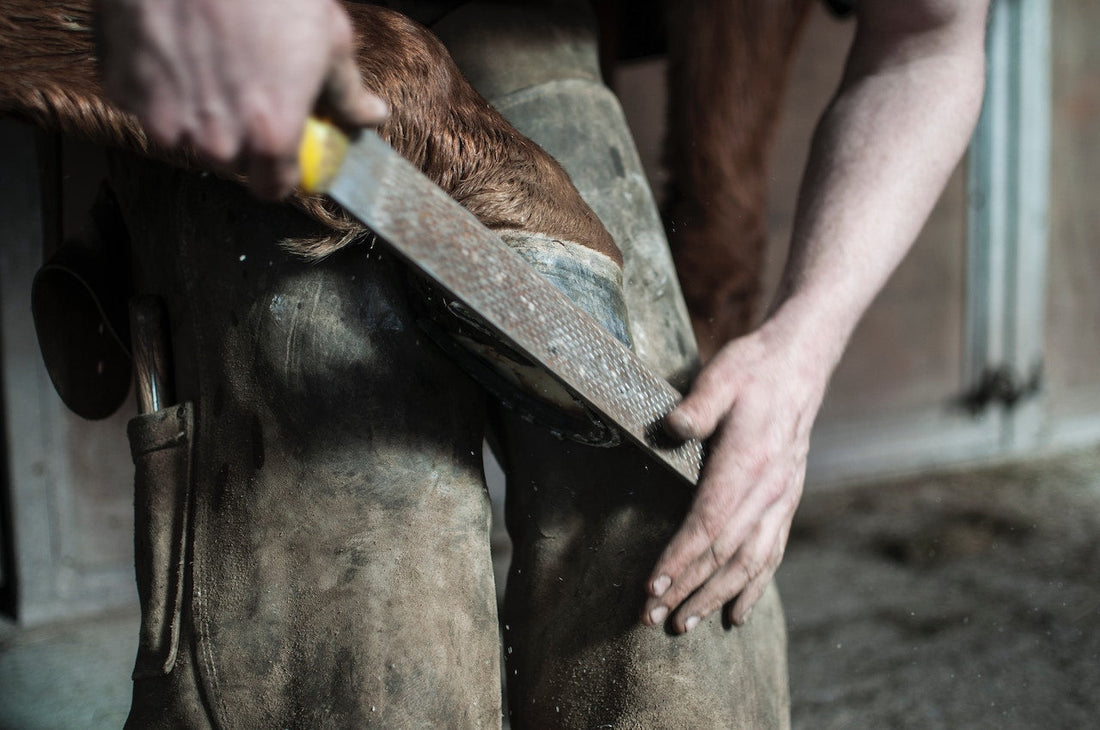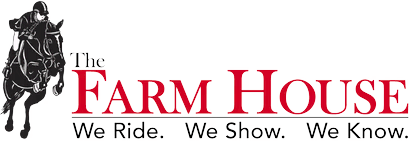
7 Hoof Care Tips for a Healthier Horse
Michelle DrumThere is a well-worn saying, “No hoof, no horse,” which goes to show just how critical hoof care is to your horse’s overall wellbeing. Hoof care is the single most important factor in keeping your horse sound and healthy. Here are some tips for proper hoof care for horses and what to look out for.
1. Recognize your horse’s normal hoof.
It’s a good idea to know the starting point for your horse’s hooves so you know when something is amiss. Check the temperature by touch. A healthy horse hoof should be slightly warm and the temperature should be consistent. Locate the digital pulse by pressing two fingers against the rear of his pastern to get a feel for the strength of the pulse. Then check the frog, located on the underside of the hoof and triangular in shape, extending mid-way from the heels towards the toe. The frog should have the texture and firmness of a new rubber eraser when it is healthy. Your horse’s hooves should be cleaned and checked regularly.
Learn more: Parts of a Horse’s Anatomy With Pictures
2. Trim regularly.
You should get your horse’s hooves trimmed regularly by a farrier or blacksmith. Six-to-eight weeks is the average — however, it depends on your horse’s hoof growth rate. In the summer, you may need more frequent farrier visits, but in the winter, you may need less.
Farriers do a couple of things for your horse in addition to trimming their hooves. First, they ensure the feet maintain proper balance. Second, they maintain the integrity and general health of all of the structural components of your horse’s hooves. Farriers play an important role in maintaining the health of your horse.
3. Care for your horse’s hooves daily.
Having a regular farrier visit does not let you off the hook for your horse’s hoof care! You should pick out your horse’s hooves on a daily basis. At a minimum, pick their hooves out before and after you ride to remove any stones, sticks, caked mud, or other small objects. It’s a good idea to repeat the exercise when you turnout in the morning and when you bring them in at night. Once you have cleaned the hooves well with the pick and brush, then do an inspection to check the condition of the hoof and shoe (if your horse wears them).
4. Provide a healthy diet.
Maintaining a horse’s nutrition can help to avoid or alleviate some hoof issues. Green pasture is often the ideal meal with the protein, vitamins, and minerals a horse needs. If you don’t have a sufficient quality pasture available, feeding good quality hay and supplementing with recommended vitamins and trace minerals can be equally effective in maintaining good health. Also, make sure your horse has access to clean, fresh water. It’s often a good idea to supplement their diet for good hoof care using products that contain biotin, iodine, methionine, and zinc.
5. Get regular exercise.
Regular exercise is a must — for both your horse and yourself. Exercise promotes overall good health and also supports the condition of their hooves as it increases circulation and promotes good growth. Provide good surfaces for your horse to walk and trot on and get your horse out as regularly as possible.
6. Provide a good pasture.
In addition to a green pasture providing a great diet for your horse, it also supplies good conditions for your horse’s hooves. Turning out a horse in an area with deep mud can cause problems for their hooves and shoes. It also makes picking multiple times a day a necessity to keep their hooves clean. Conversely, if the pasture is too dry, the horse’s feet can dry out, causing them to crack and split, or drive the horseshoe nails through the hoof.
7. Protect the hooves during transport.
Be sure to cover your horse’s hooves during transport to make sure your horse doesn’t injure himself. It’s easy for horses to step on the edge of a shoe while hauling, pulling it partially loose. In this case, you run the risk of your horse standing on the nails. Bell boots or travel boots are a good idea to keep your horse safe during transport.
Horse Hooves Require Regular Attention
A horse’s hooves require regular care and attention. Ideally, you should clean and examine your horse’s hooves daily. Though many people rely on their farrier, you can identify issues quickly before they become a problem with regular attention.
What to Look for with Your Horse’s Hooves
When you regularly clean and inspect your horse’s hooves, you can get an early start finding any problems. These issues can become very serious, so if you do find any problems, reach out to your farrier and vet right away.
Good hoof balance
This is something your farrier will regularly look for, but you should also get used to seeing what it looks like. You should see a straight line from the pastern down the front of the hoof wall with a toe that is not too long and it is rounded or squared. The shoe should extend back to the end of the hoof wall and the hoof should land evenly from side-to-side while your horse is walking.
Good shoeing and trimming
Look for long toes and collapsed heels or short toes and long heels, both of which cause strain.
Hoof cracks
There are three different types of hoof cracks. These could be horizontal cracks, or blowouts, usually caused by an injury to the coronary band. Grass cracks are often seen in unshod horses. Sand cracks form from an injury to the coronary band or white-line disease that breaks out on the coronary band.
Blowouts are often caused by weather (either excessively dry weather or frequent changes from wet to dry) or trimming intervals that are too long. Hoof moisturizer, good nutrition with hoof supplements, and increased hoof trimming should help. For grass cracks, trimming and shoeing your horse can correct them. Sand cracks may result in lameness and will require working with your vet to determine the cause of the cracks and removing it. Treatment may include not letting your horse bear weight on the damaged hoof and patching the crack. It can take 9 – 12 months to grow it out.
Hot nail or street nail
When a hot nail or any foreign object is driven into the structures of the hoof wall, it will usually cause lameness. This is an emergency and you should contact your vet immediately. Treatment generally involves flushing the area with antiseptic and packing the hole or bandaging the foot. A tetanus booster is advised.
Thrush
Thrush is a foul-smelling oozy black liquid that will show around the frog. It’s generally due to wet, soiled conditions. Thrush is serious because it can cause lameness as it invades the sensitive tissues of the hoof. Keeping barn stalls clean and dry helps to eliminate this problem.
Abscess
This hoof sole infection can lead to severe sudden lameness. It can be caused by bruising, trauma, or a foreign body. In order to treat abscess, the foreign body should be removed and soak the hoof in warm water with Epsom salt. Then keep the hoof bandaged, dry, and clean.
Additionally, if you notice any inflammation, rotation, or an unusual gate, notify your farrier and vet right away.
If you notice heat, swelling, a change in gait, or changes in your horses digital pulse, you’ll want to contact your vet or farrier immediately. Knowing how to properly care for your horse’s hooves and what issues to look for is key to your horse’s health and wellbeing. Keeping your horse healthy and happy requires the partnership of you, your vet, and your farrier. This partnership will result in the health and happiness of your horse.
You might also like:

1 comment
It caught my attention when you said that it is a must for your horse since it promotes good health and supports the condition of their hooves. This is a good tip for me because I am planning to shop for horses that I can care for. Maybe, it will also be ideal for me to find an advocacy that I can support for horses’ protection. Thanks for sharing this. https://americanequineawareness.org